Another French city, another single day to make the best of it! I rocked into Lyon with my increasingly battered bag and checked into the Slo Living Hostel, which was slightly more upmarket than my previous digs. I snagged a tourist map and a free glass of wine and proceeded to plan my wandering way through the third most populous city of France.

The next morning I set off bright and early down Cours Gambetta, heading for Vieux Lyon and the Fourvière Hill beyond – yes another old town and another famous hill, but this time it’s a UNESCO World Heritage Site!
As I walked, an older gentleman began to keep pace with me, nattering away to me in French. I couldn’t understand what he wanted, but based on the track record of men who follow strange women down the street, I could only assume that my feminine virtue was once again under threat. Incidentally, many people had warned me that Italian men would be sleazy but I’d had no trouble at all in Italy. Now that I was in France I was encountering creeps on a daily basis, but rather than blame the French I guess I’ll put it down to the fact that I’m now a woman travelling alone.
I eventually lost the weirdo and made my way to Pont de la Guillotière, one of many bridges across the river Rhône, one of two rivers that converge in Lyon.
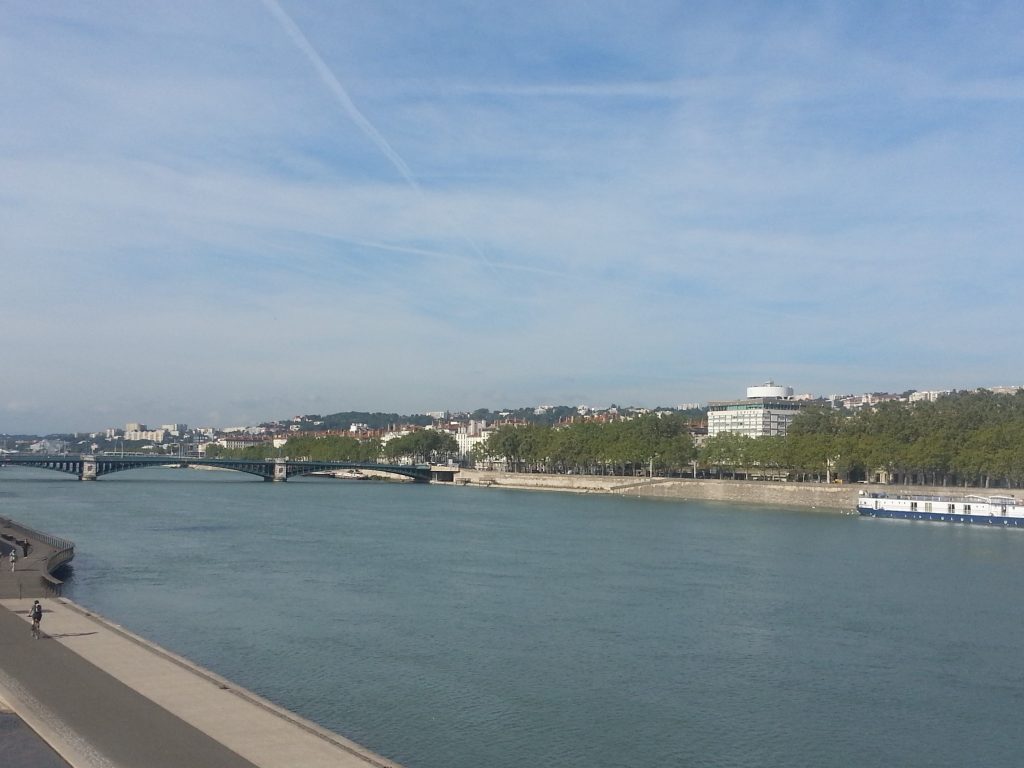
I crossed the wide calm river, duly admiring the white swans, and entered the large open square of Place Bellecour, one of the largest open squares in Europe. It’s had many names over the years, starting with Place Royale and Place Louis-le-Grand when it was first constructed by Louis XIV in 1715, then passing through Place de la Fédération and Place de l’Égalité during the French Revolution, and then becoming Place Bonaparte and Place Napoléon during the Napoleanic age. Since 1871 it has been known as Place Bellecour, but who knows what it might be in future.
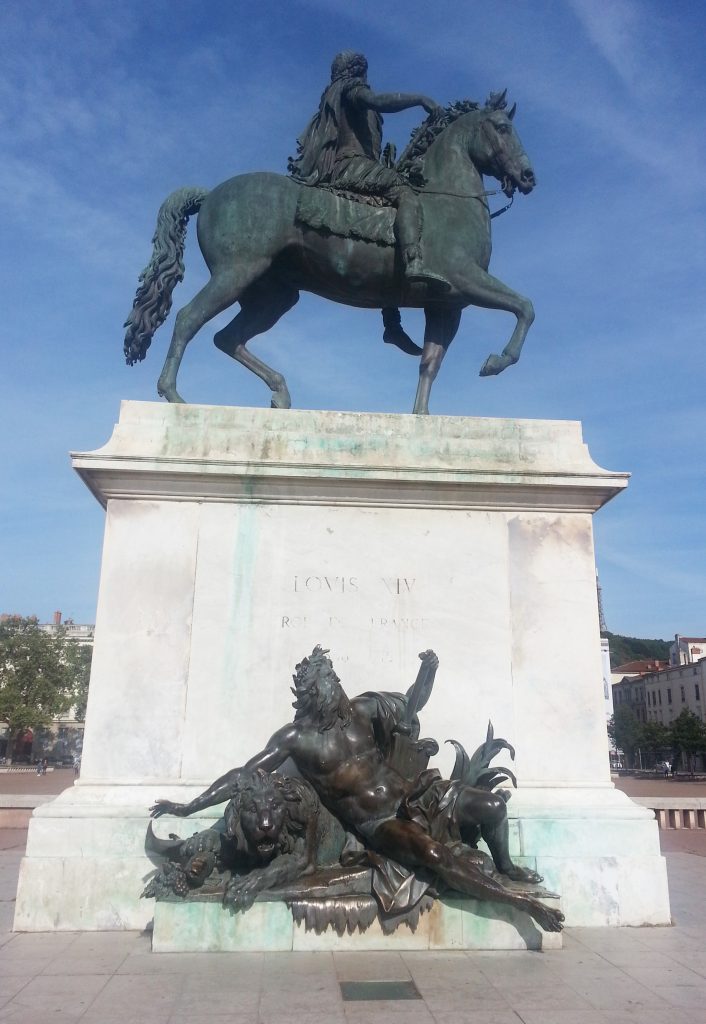
I carried on past the square and crossed Lyon’s other river, the Saône. Above me was the hill I sought but first a little detour was in order – I’d heard tell of secret passages through the heart of Lyon, originally built to service textile workers carrying their wares to the rivers and later used to plot rebellions and by the French Resistance to evade their German occupiers. The oldest may be as much as 1700 years old.
I was searching for La Longue Traboule, the longest traboule in town which runs through four different buildings. I knew it was in the area of Cathédrale Saint-Jean-Baptiste, so I passed by the 14th century cathedral as I searched.
Next door to the cathedral are the ruins of two older churches, one of which dates to the 4th century, thus making it the oldest church in Lyon. I suppose the homeless people who now sleep against its crumbling wall care little for this fact.

Then it was time to search the surrounding streets for secret tunnels. It would have been difficult to distinguish the traboule which I sought from the surrounding doorways had it not had a golden plaque mounted next to it. Pushing on the unassuming green door led me into a darkened tunnel.

Creeping quietly along the passage (visitors to the traboules must respect the fact that people live in the surrounding buildings), I passed beneath intermittent openings to the sky four stories above which were the only source of light.

Eventually I found the exit and emerged into the street a full block away from where I’d started. I can definitely see how such passages would be helpful to a person fleeing from occupying soldiers – being able to pop into one building and come out somewhere completely different must have been handy.
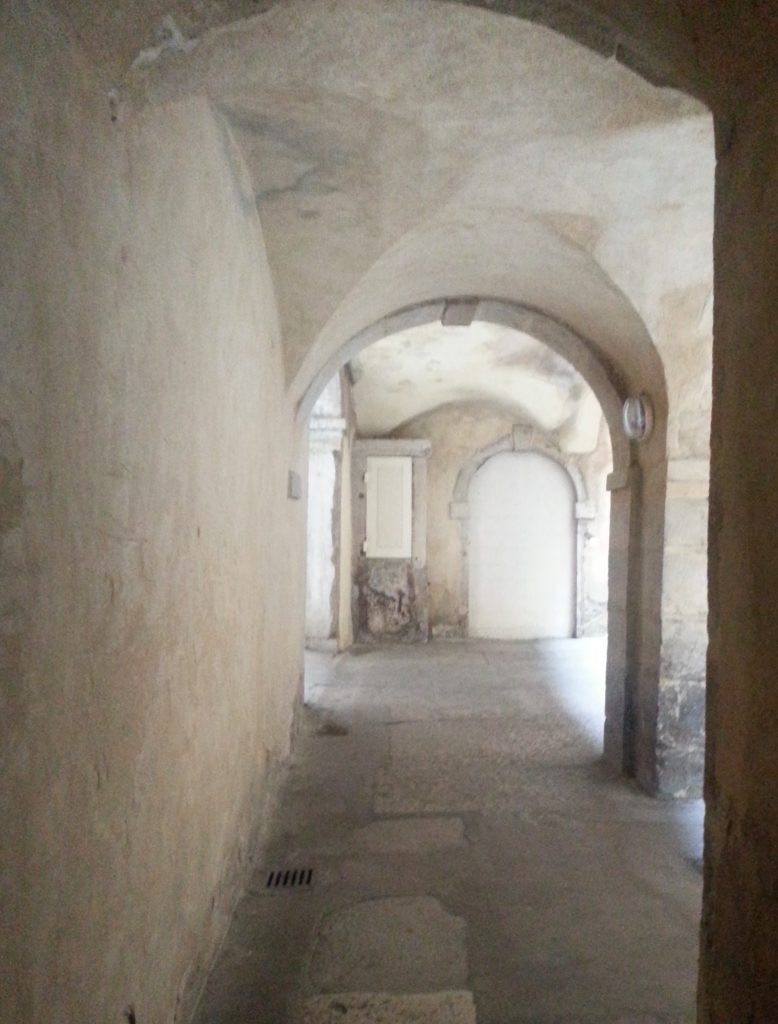
After that exciting little detour I finally made my way up the hill through a scenic garden. My next stop was La Basilique Notre Dame de Fourvière, another Notre Dame but still not the one where Quasimodo famously hung out. Built between 1872 and 1884, the basilica is dedicated to the Virgin Mary who has been credited with saving the city many times from disease and invasion.
But what drew my attention more was the view over the city from next to the basilica. From here Lyon appeared to be all chimneys, and it I decided it was satisfactorily French-looking after Italian-looking Nice.

Passing the basilica, I eventually managed to find the archaeological park which contains the amazing excavated Gallo-Roman theatre and surrounding buildings, relics of the city of Lugdunum which was founded here in 43BC. Conveniently sited at the confluence of two navigable rivers, the city grew quickly and soon became the capital of Roman Gaul.
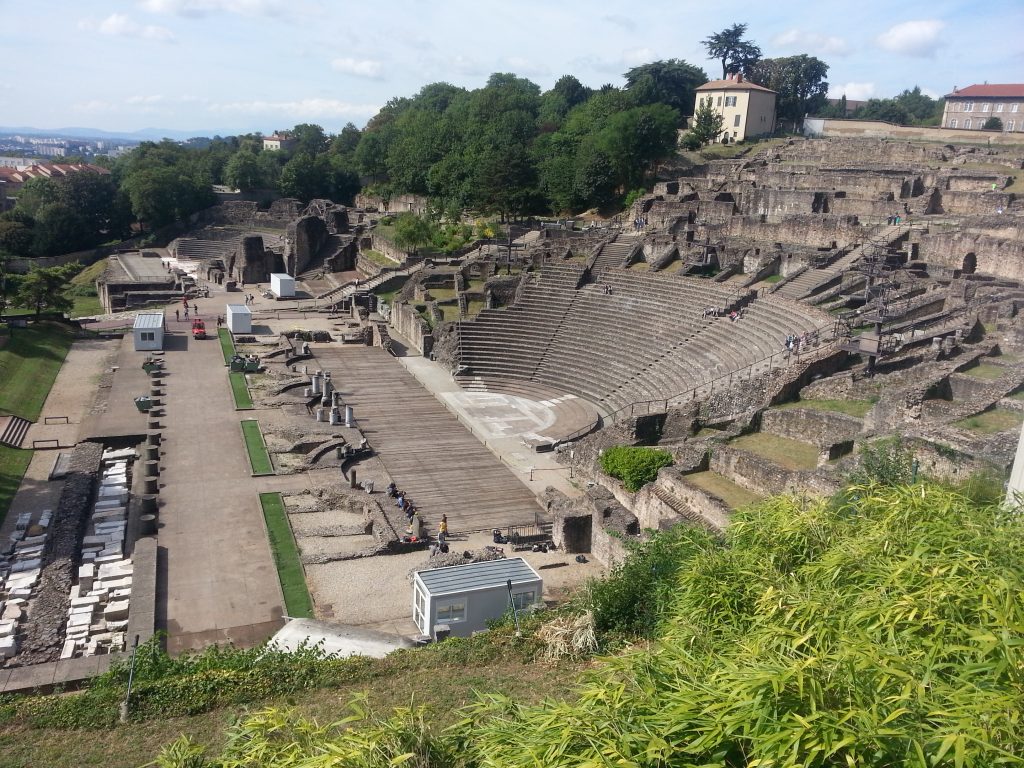
You can walk freely around the ruin, so that is what I did, wandering the same streets as this city’s first settlers might have done almost two thousand years ago. After exploring the back streets, I sat on one of the many tiers of seats and tried to imagine what it might have been like to have been one of the 11000 spectators that could have been packed into here back when it was new.
As I left the park, I passed an ancient wall covered by a rambling grape vine. My romantic imagination hoped that it might be the same strain of grapes grown by those who lived here two thousand years before.
My path next took me past the Cemetery of Loyasse, established in the 19th century for the richer citizens of Lyon. There is a striking monument opposite the gate, commemorating the victims of several terrible events, the ones I could track down being a deadly landslide on this very hill in 1930, an LPG factory explosion which resulted in the deaths of 18 people near the town of Feyzin in 1966, and of course the First and Second World Wars.

I wandered about for a little while, admiring the many rows of impressive family headstones, some taller than me. Standard headstones seemed to be the order of the day, rather than the intricate and emotive sculptures that had impressed me so much in Nice.
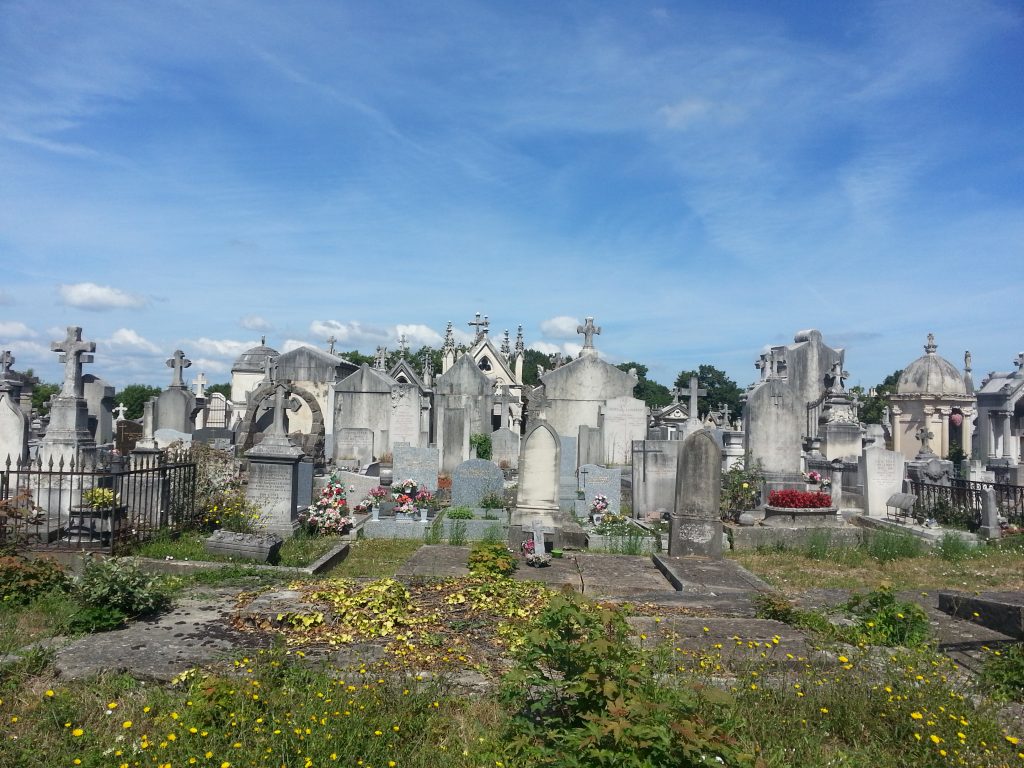
Hungry, I made my way down the hill in search of lunch, and chose The Crock’n’roll simply because I can’t pass by a pun like that. After a delicious toasted sandwich of tomato, cheese, mayo and lettuce I was ready to continue. My traitorous feet were getting sore again, but I had one more place I definitely wanted to check out before I headed back to the hostel – the Cour de Voraces traboule, one of the most striking and famous traboules in Lyon. Unfortunately this meant I had to make my aching way over to the Croix-Rousse textile district which was outside the Vieux Lyon district I’d so far been sticking to.
Crossing back over the Saône, I headed slowly to the Croix-Rousse district, dismayed to find that it too was up a hill. Eventually I found Place Colbert which I’d heard was the location of one of three entrances to the famous traboule and after wandering back and forth for a while I eventually found the way in.
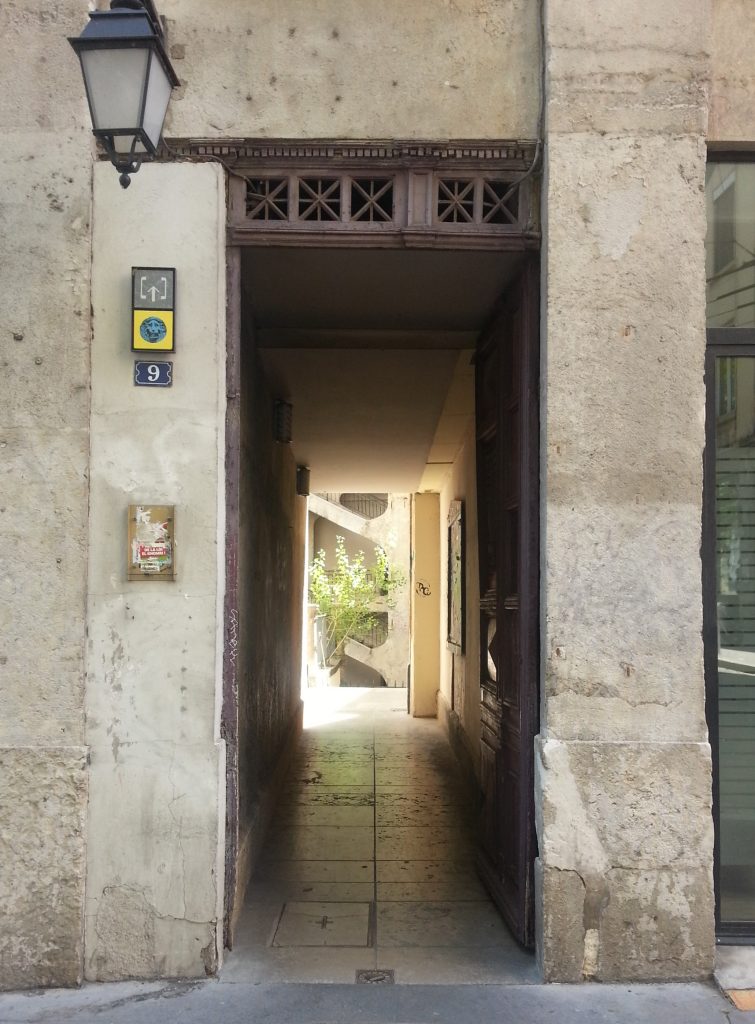
This traboule is famous for being a shelter for the textile workers (or canuts) during several revolts which occurred during the industrial revolution, including one against reducing the size of a carafe of wine (sounds reasonable to me!). Also famous is the six-story stone staircase to be found within.

Unsure where the rest of the exits were, I climbed the staircase just in case there was a way out up top. This turned out to not at all be the case, so I made my way back down and discovered that I should actually have gone down a level, where a dark narrow tunnel leads out into an alley behind the building, and from there out into another street.

With that I limped back to the hostel to rest my aching feet. As evening came on I began to feel peckish but was rather exhausted and not sure if I could cope with going out and trying to speak French. So when I heard my two Aussie dorm-mates discussing dinner options, I was quick to insinuate myself and tag along. On the recommendation of one of our hostel hosts, we crossed the Rhône again to the bustling restaurant district near Place Bellacour. To my great shame I have forgotten the name of the place we were directed to, but we were told that we’d be lucky to get a seat as it was very popular.
The place was indeed packed, but we were able to share a table with some other customers and eventually managed to order some mystery items off the menu. It turned out that this eatery specialised in…things on toast? Essentially the dishes consisted of toast or bread with various toppings. I had bread with salmon and creme fraiche, which was nice, but I must confess that I didn’t entirely “get” the experience. On the other hand, an entire restaurant full of customers seemed to disagree.
Full of toast and toppings, we returned to the hostel, and I quickly made my way to bed. Lyon was fun, but is probably the only place I’ve visited so far that I’m not gutted about leaving. Sure, I wouldn’t be devastated to come back – I’ve only seen two out of more than forty traboules after all! But I almost wish I’d spent another day lying on the beach at Nice instead of coming here. Perhaps I’m suffering from adventure overload!
Regardless, tomorrow is another day and another train ride as I slowly make my way towards the UK. What will I encounter on the way? Only time will tell!
References:
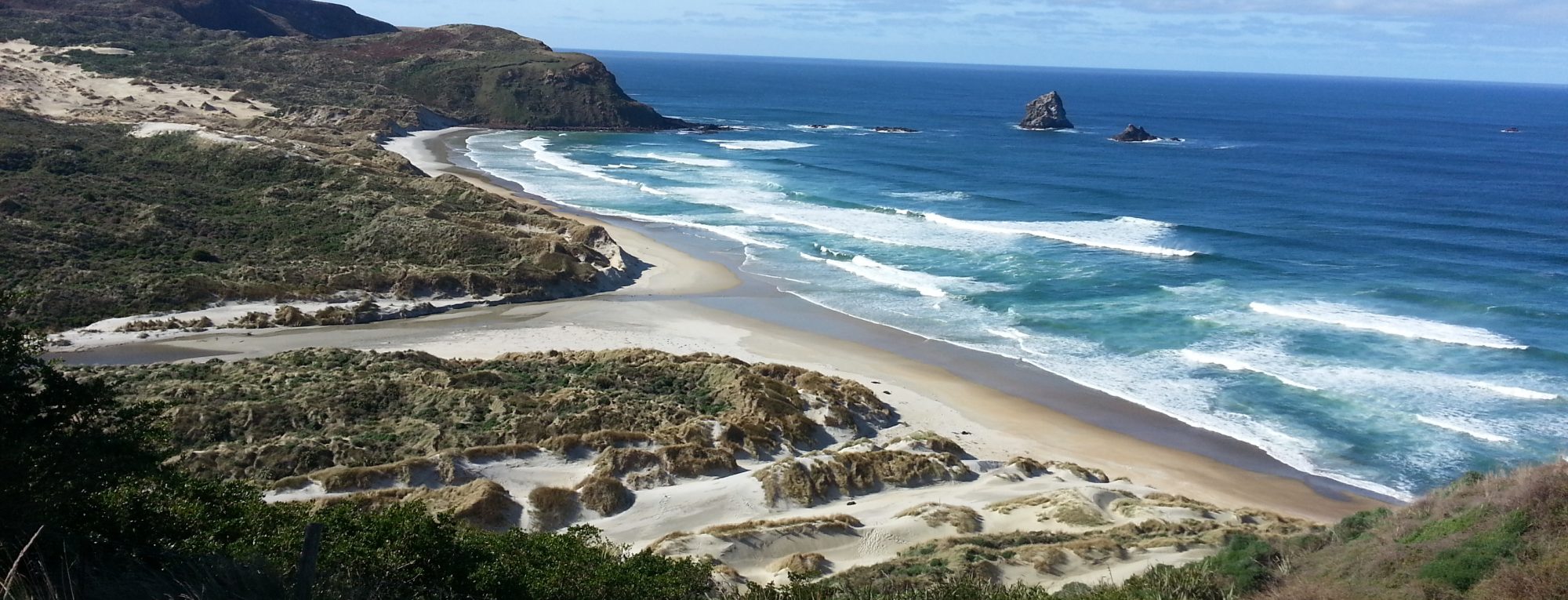
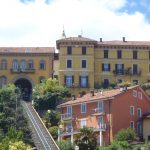


Another exciting adventure..